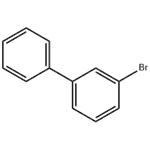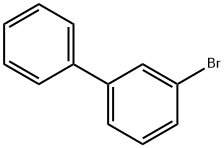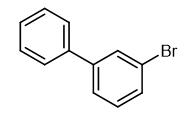Synthesis and Pharmaceutical Applications of 3-Bromobiphenyl
3-Bromobiphenyl is an organic compound with the chemical formula C₁₂H₉Br. It appears as a pale yellow liquid with a density of 1.398 g/cm³ at 20°C, a boiling point of 300°C under atmospheric pressure. This substance is insoluble in water but soluble in ethanol and diethyl ether. It is light-sensitive and should be stored protected from light. 3-Bromobiphenyl is primarily used as an intermediate in organic synthesis, as a raw material for fungicides in agriculture, and in industrial disinfectants. Although it is not considered ecologically hazardous to aquatic systems, unauthorized discharge is prohibited.
Synthesis
Method 1
The synthesis of 3-Bromobiphenyl typically involves a multi-step process starting from biphenyl. The process includes nitration, reduction, bromination, and deamination steps. A common method involves the reaction of 1-bromo-3-iodobenzene with phenylboronic acid in the presence of a palladium catalyst, resulting in the formation of 3-Bromobiphenyl. This method is favored for its simplicity and the ease of product separation.
Method 2
The invention discloses a 3-bromobiphenyl preparation method which is as follows: using biphenyl as a raw material, performing four steps of reaction of nitration, reduction, bromination and deamination, then extracting for separation to finally obtain 3-bromodiphenyl. The method is simple, and the product is easy to separate.[1]
Method 3

Figure1: Preparation of 3-Bromobiphenyl
To an oven-dried quartz tube equipped with a stir bar was sequentially charged with aryl carboxylic acid (0.2 mmol), 2,8-Dichloroindolo[2,1-b]quinazoline-6,12-dione (20 mol%), Cs₂CO₃ (30 mol%), and 1,3-Diethyl 2-bromo-2-methylpropanedioate (1 mmol). Under an ambient air atmosphere, EtOAc (4.0 mL) was added as the solvent. The reaction mixture was then irradiated for 4 hours in a parallel photo-reactor system (410–415 nm LEDs, 10 W per position) under continuous stirring while maintaining temperature at 35–40°C through an integrated coolant circulation system. Concentrate the solvent under reduced pressure. Purify the residue by column chromatography on silica gel to obtain 3-Bromobiphenyl. [2]
Medical Applications
3-Bromobiphenyl serves as an important intermediate in the synthesis of various pharmaceutical compounds. It is used in the production of benzene sulfonamide derivatives, which are known inhibitors of 12-LOX, an enzyme involved in inflammatory processes. Additionally, it is utilized in the preparation of pyrrolidine derivatives, which are inhibitors of GlyT1, a transporter protein implicated in neurological disorders.
Liquid Crystal Production
The liquid crystal display industry relies critically on 3-bromobiphenyl for manufacturing liquid crystal displays, where this compound's distinctive molecular architecture and reactive characteristics enable its utilization as a fundamental synthetic building block for constructing advanced liquid crystalline materials that form the operational foundation of modern display technologies. In recent years, the market demand for 3-bromobiphenyl within this sector has demonstrated consistent and substantial growth, with particularly pronounced consumption patterns observed in East Asian technological powerhouses such as Japan and South Korea, where large-scale LCD panel manufacturing infrastructures dominate global production capacity.
Amination Reaction

Figure 2: Amination Reaction of 3-Bromobiphenyl
An oven-dried 10 mL undivided electrochemical cell equipped with a magnetic stir bar was charged with NiBr₂·3H₂O (5 mol%), bipyridine (5 mol%), and a mixed solvent system of DMSO:THF (5:1 ratio, 4.8 mL total volume) under an inert atmosphere inside a glovebox, followed by stirring at room temperature for 2 hours to pre-activate the catalytic system. Add the3-bromobiphenyl (0.5 mmol), TBAB (1.0 mmol) and DBU (6.0 eq.) with a Zn anode (10 mmx15 mmx3 mm) and a Ni foam cathode (10.0 mmx15.0 mmx0.1 mm). Seal the undivided cell. Remove the undivided cell from glove box. Evacuate the undivided cell and back-fill under NH3 flow (repeat three times). Perform the electrocatalysis at 85°C with a constant current of 2 mA maintained for 12 hours with a balloon (NH3 or NH3 mixture with Ar). Dilute the mixture with ethyl acetate. Cool the mixture to room temperature. Wash the organic phases with saturated brine (3x10 mL). Dry the organic phases over anhydrous sodium sulfate. Concentrate the solvent under reduced pressure. Purify the residue by column chromatography on silica gel (Petroleum ether/EtOAc = 4:1) to obtain [1,1'-biphenyl]-3-amine. [3]
Reference
[1] Zhi Li, A kind of method for preparing 3-bromobiphenyl, Chinese Invention Patent, Patent Number: CN103936551A.
[2] Hu, Chun-Hong; et al, Organic charge-transfer complex induces chemoselective decarboxylation to aryl radicals for general functionalization, Chem 2023, 9, 2997-3012.
[3] Liu, Yaowen; et al, Electrochemical Amination of Aryl Halides with NH3, Angewandte Chemie, International Edition 2025, 64, e202504459.
You may like
Related articles And Qustion
See also
Lastest Price from 3-Bromobiphenyl manufacturers

US $0.00-0.00/kg2025-04-21
- CAS:
- 2113-57-7
- Min. Order:
- 1kg
- Purity:
- 99.9HPLC
- Supply Ability:
- 20 tons

US $30.00-10.00/KG2025-04-15
- CAS:
- 2113-57-7
- Min. Order:
- 50KG
- Purity:
- 99%
- Supply Ability:
- 500000kg


